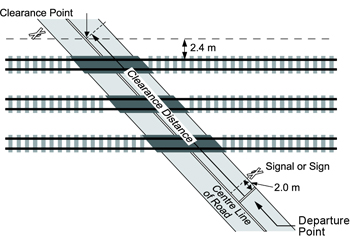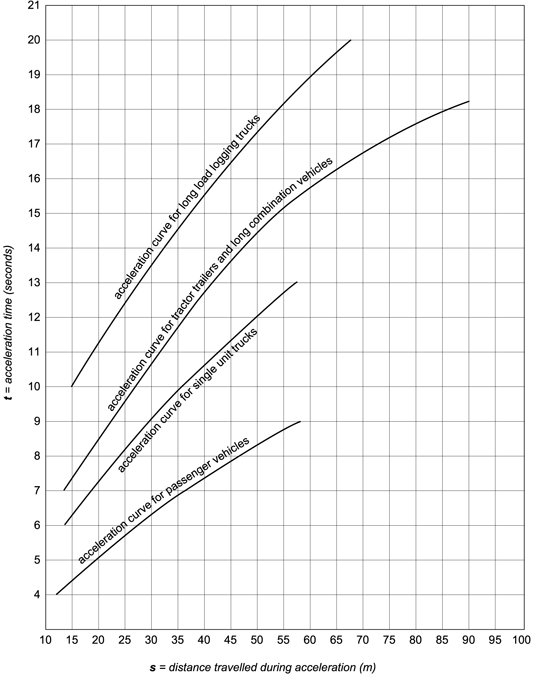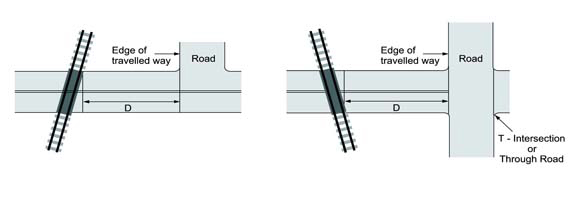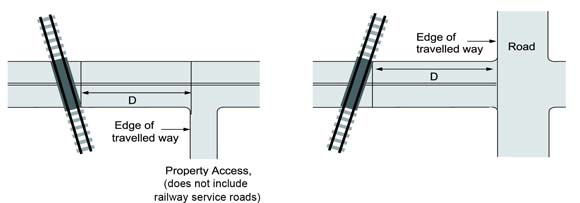10. Design Considerations
10.1 Clearance Distance (cd)
10.1.1 Clearance Distance (cd) is the distance between the clearance point in advance of the grade crossing, to the clearance point beyond the farthest rail, as shown in Figure 10-1.
10.1.2 The clearance point is the point 2.4 m beyond the outside edge of the farthest rail from the departure point measured perpendicular to the rail.
10.2 Vehicle Travel Distance (s)
10.2.1 The total distance, in metres, the design vehicle must travel during acceleration to pass completely through the Clearance Distance (cd) is calculated using the following formula:
s = cd + L equation 10.2
where,
cd = Clearance Distance in metres; and
L = the total length, in metres of the design vehicle.
(a) For Grade Crossings with a Warning System or Railway Crossing Sign
Figure 10-1 (a) - Text version
Figure 10-1 has two diagrams with measurements and arrows illustrating the location of a signal or sign, clearance point, clearance distance, centerline of road, and direction of travel on a grade crossing.
The clearance point is the closest point on the departing lane of a grade crossing that is 2.4 m from the nearest rail measured perpendicular to the rail. The departure point of the clearance distance measurement is 2.0 m before the signal or sign.
Figure 10-1 (b) - Text version
The clearance point is the closest point on the departing lane of a grade crossing that is 2.4 m from the nearest rail measured perpendicular to the rail. The departure point of the clearance distance measurement is 2.0 m before the signal or sign. If there's no sign or signal, the starting point is at 5.0 m measured perpendicular from the nearest rail.
10.3 Departure Time - General
10.3.1 The Departure Time is the greater of the time required for the design vehicle to pass completely through the Clearance Distance (cd) from a stopped position (TD) or the time required for pedestrians, cyclists and persons using assistive devices to pass completely through the Clearance Distance (cd) (TP).
Table 10-1 Ratios of Acceleration Times on Grades must be used to account for the effects of road gradient on the design vehicle for the grade crossing. The established ratio of acceleration time (G) must be incorporated into the Acceleration Time (T) by multiplying the acceleration time on level ground (t) by the ratio of acceleration time (G).
10.3.2 Departure Time - Design Vehicle (TD)
The total time, in seconds, the design vehicle must travel to pass completely through the Clearance Distance (cd) is calculated using the following formula:
TD = J + T equation 10.3a
where,
J = the perception-reaction time, in seconds, of the crossing user to look in both directions, shift gears, if necessary, and prepare to start (must use 2 seconds at minimum); and
T = the time, in seconds, for the grade crossing design vehicle to travel through the Vehicle Travel Distance (s) taking into account the actual road gradient at the grade crossing.
T may be obtained through direct measurement or calculated using the following formula:
T = (t x G) equation 10.3b
where,
t = the time, in seconds, required for the design vehicle to accelerate through the Vehicle Travel Distance (s) on level ground established from Figure 10-2 Assumed Acceleration Curves; and
G = the ratio of acceleration time established from Table 10-1 Ratios of Acceleration Times on Grade or may be obtained through direct measurement.
10.3.3 Departure Time – Pedestrians, Cyclists and Persons Using Assistive Devices (TP)
The total time, in seconds, that pedestrians, cyclists and persons using assistive devices must travel to pass completely through the Clearance Distance (cd) is calculated using the following formula:
Tp= cd / Vp equation 10.3c
where,
cd = the Clearance Distance, in metres (Article 10.1); and
Vp = the average travel speed, in metres per second (m/s), for pedestrians, cyclists, and persons using assistive devices (to a maximum value of 1.22 m/s).
10.4 Gate Arm Clearance Time
10.4.1 Gate Arm Clearance Time is the greater of TG ssd or TG stop and represents the time, in seconds, it takes the design vehicle to travel from either the Stopping Sight Distance (SSD) position or the Stop position to the point past the gate arm.
Gate Arm Clearance Time from SSD postion (TG ssd) is calculated as follows:
TG ssd = cdG ssd/(0.27 x Vroad) equation 10.3c
Where:
Vroad = the road crossing design speed over the crossing in kilometres per hour (km/h); and
cdG ssd = SSD + 2 m + L
where,
SSD is the stopping sight distance, in metres, and is calculated using the following formula:
SSD = 0.278 x 2.5 x V + d
- d = braking distance (m)
- V = initial speed (km/h)
- L = the total length, in metres, of the design vehicle
Gate Arm Clearance Time from the Stop position (TG stop) is calculated as follows:
TG stop = J + (tcdG stop x G)
where,
J = 2 seconds, and is the perception-reaction time, in seconds, of the crossing user to look in both directions, shift gears, if necessary, and prepare to start; and
G = the ratio of acceleration time established from Table 10-1 Ratios of Acceleration Times on Grade or may be obtained through direct measurement; and
tcdG stop = the time, in seconds, required for the design vehicle to accelerate through the Gate Arm Clearance Distance (cdG stop) on level ground established from Figure 10-2 Assumed Acceleration Curves; (Note; (cdG stop) is used in place of (s) and (tcdG stop) is used in place of (t) from Figure 10-2)
where,
cdG stop = 2 m + L
where,
L = the total length, in metres, of the design vehicle.
Figure 10-2 - Text version
In the graph, the acceleration time is plotted against the distance travelled during vehicle acceleration. Illustrated are the acceleration curves for; long load logging truck which shows an acceleration time of approximately 10 seconds to 20 seconds and travels a distance of approximately 15 meters to 67 meters, tractor trailers and long combination vehicles which shows an acceleration time of approximately 7 seconds to 18 seconds and travels a distance of approximately 14 meters to 90 meters, single units trucks which shows an acceleration time of approximately 6 second to 13 second and travels a distance of approximately 14 meter to 57 meter and passenger vehicles which shows an acceleration time of approximately 4 second to 9 second and travels a distance of approximately 12 meter to 57 meter, based on the distance travelled during acceleration (meter) and the acceleration time (seconds)
|
Design Vehicle |
Road Grade (%) |
||||
|---|---|---|---|---|---|
| -4 | -2 | 0 | +2 | +4 | |
| Passenger Car | 0.7 | 0.9 | 1.0 | 1.1 | 1.3 |
| Single Unit Truck & Buses | 0.8 | 0.9 | 1.0 | 1.1 | 1.3 |
| Tractor-Semitrailer | 0.8 | 0.9 | 1.0 | 1.2 | 1.7 |
| Source: Geometric Design Guide for Canadian Roads, published by the Transportation Association of Canada and dated September 1999 | |||||
Table 10-2 Road Design Specification for Road Approach
|
Column A |
Column B |
Column C |
|---|---|---|
| Rural | Local | Divided |
| Collector | ||
| Urban | Arterial | Not Divided |
| Expressway | ||
| Freeway |
| Rural Locals | Rural Collectors | Rural Arterials | Rural Freeways | |
|---|---|---|---|---|
| Service function | Traffic movement secondary consideration | Traffic and land access of equal importance | Traffic movement primary consideration | Optimum mobility |
| Land service | Land access primary consideration | Traffic movement and land access of equal importance | Land access secondary consideration | No access |
| Traffic volume vehicles per day (typically) | <1000 AADT | <5000 AADT | <1 2000 AADT | >8000AADT |
| Flow characteristics | Interrupted flow | Interrupted flow | Uninterrupted flow except at | free flow (grade separated) major intersections |
| Design speed (km/h) | 50 – 110 | 60 - 110 | 80 – 130 | 100 – 300 |
| Average running speed (km/h) (free flow conditions) | 50 – 90 | 50 – 90 | 60 – 100 | 70 -110 |
| Vehicle type | Predominantly passenger cars, light to medium trucks and occasional heavy trucks | All types, up to 30% trucks in the 3 t to 5 t range | All types, up to 20% trucks | All types, up to 20% heavy trucks |
| Normal
connections |
Locals
collectors |
Locals
collectors arterials |
Collectors
arterials freeways |
Arterials
freeways |
| Source: Geometric Design Guide for Canadian Roads, published by the Transportation Association of Canada and dated September 1999 | ||||
| Public Lanes
Residential |
Public Lanes
Commercial |
Locals
Residential |
Locals
Indust./Comm. |
Collectors
Residential |
Collectors
Indust./Comm |
Arterials
Minor |
Arterials
Major |
Expressways | Freeways | |
|---|---|---|---|---|---|---|---|---|---|---|
| Traffic service function | Traffic movement not a consideration | Traffic movement not a consideration | Traffic movement secondary consideration | Traffic movement secondary consideration | Traffic movement and land access of equal importance | Traffic movement and land access of equal importance | Traffic movement major consideration | Traffic movement primary consideration | Traffic movement primary consideration | Optimum mobility |
| Land service/ access | Land access only function | Land access only function | Land access primary function | Land access primary function | Traffic movement and access of equal importance | Traffic movement and access of equal importance | Some access control | Rigid access control | No access | no access |
| Traffic volume (veh/day) (typical) | <500 | <1000 | <1000 | <3000 | <8000 | 1000-12 000 | 5000 – 20 000 | 10 000 – 30 000 | >10000 | <20 000 |
| Flow characteristics | Interrupted flow | Interrupted flow | Interrupted flow | Interrupted flow | Interrupted flow | Interrupted flow | Uninterrupted flow except at signals and crosswalks | Uninterrupted flow except at signals and crosswalks | Uninterrupted flow except at signals | Free-flow (grade separation) |
| Design speed (km/h) | 30-40 | 30-40 | 30 – 50 | 30 – 50 | 50 - 80 | 50 - 80 | 40-60 | 50-90 | 80 – 110 | 80- 120 |
| Average Running speeds (km/h)
(off-peak) |
20 - 30 | 20 - 30 | 20 - 40 | 20 - 40 | 30 - 70 | 30 - 70 | 40 - 60 | 50 -90 | 60 - 90 | 70 – 110 |
| Vehicle type | Passenger and service vehicles | All types | Passenger and service vehicles | All types | Passenger and service vehicles | All types | All types | All types up to 20% trucks | All types up to 20% trucks | All types up to 20% trucks |
| Desirable connections | Public lanes, locals | Public lanes, locals | Public lanes, locals, collectors | Public lanes, locals, collectors | Locals, collectors, arterials | Locals, collectors, arterials | Collectors, arterials, expressways, freeway | Collectors, arterials, expressways, freeway | Arterials, expressway, freeways | Arterials, expressways, freeways |
| Transit service | Public lanes, locals | Public lanes, locals | Public lanes, locals, collectors | Public lanes, locals, collectors | Locals, collectors, arterials | Locals, collectors, arterials | Express and local busses permitted | Express and local busses permitted | Express buses only | Express buses only |
| Accommodation of cyclists | No restriction or special facilities | No restriction or special facilities | No restriction or special facilities | No restriction or special facilities | No restriction or special facilities | No restriction or special facilities | Lanes widening or separate facilities desirable | Lanes widening or separate facilities desirable | prohibited | prohibited |
| Accommodation of pedestrians | Pedestrian permitted, no special facilities | Pedestrian permitted, no special facilities | Sidewalks normally on one or both sides | Sidewalks provided where required | Sidewalks provided both sides | Sidewalks provided where required | Sidewalks may be provided, separation for traffic lanes preferred | Sidewalks may be provided, separation for traffic lanes preferred | Pedestrian Prohibited | Pedestrian Prohibited |
| Parking (typically) | Some restrictions | Some restrictions | No restrictions or restrictions one side only | No restrictions or restrictions one side only | Few restrictions other than peak hour | Few restrictions other than peak hour | Peak hour restriction | Prohibited or peak hour restriction | prohibited | prohibited |
| Min. Intersection spacing1 (m) | As needed | As needed | 60 | 60 | 60 | 60 | 200 | 400 | 800 | 1600 (between interchanges) |
| Right-of-way width (m) (typically) | 6 - 10 | 6 - 10 | 15 - 22 | 15 - 22 | 20 - 24 | 20 - 24 | 202 - 453 | 202 - 453 | >453 | >603 |
| Source: Geometric Design Guide for Canadian Roads, published by the Transportation Association of Canada and dated September 1999 | ||||||||||
11. Location of Grade Crossings
11.1 A public grade crossing where the railway design speed is more than 25 km/h (15 mph) must be constructed so that no part of the travelled way of an intersecting road or entranceway (other than a railway service road), is closer than 30 m (D) to the nearest rail of the grade crossing (see Figure 11-1).
Figure 11-1, Diagram 1
Figure 11-1, Diagram 1 - Text version
As provided for in article 11.1 a public grade crossing must be constructed so that no part of the travelled way of an intersecting road is closer than 30 m to the nearest rail of the grade crossing.
Figure 11-1, Diagram 2 - Text version
As provided for in article 11.1 a public grade crossing must be constructed so that no part of the travelled way of an entranceway (other than a railway service road), or the stop line or position of a traffic control device is closer than 30 m to the nearest rail of the grade crossing.




